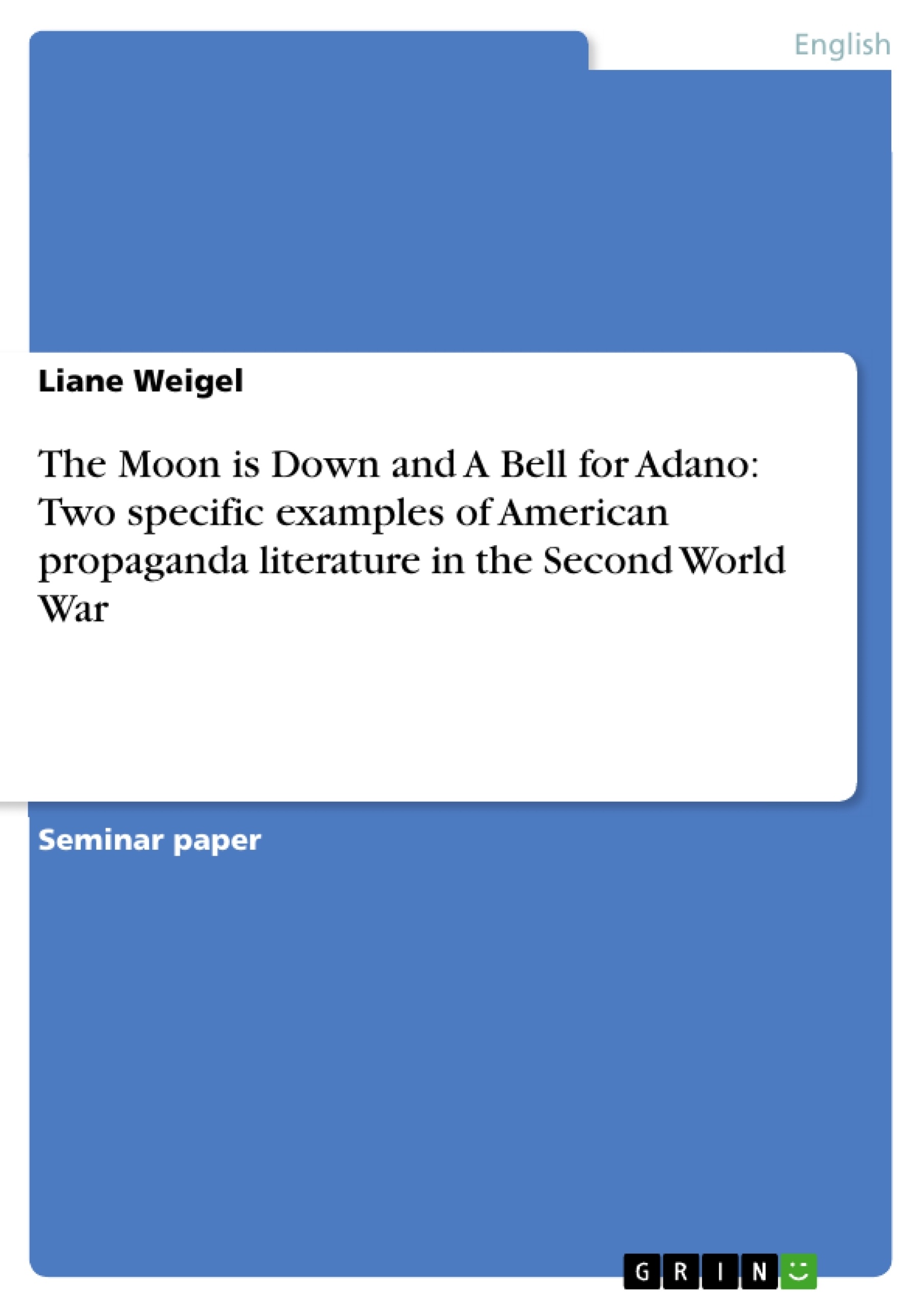“By ten- forty-five, it was all over. The town was occupied, the defenders defeated, and the war finished” and “Invasion had come to the town of Adano.” these are the opening lines of John Steinbeck's novel The Moon is Down and John Hersey’s A Bell for Adano. Although the first merely describes, what could happen when an invading army proclaims “mission accomplished” prematurely because of undemocratic and inhumane oppression and the second focuses on a humanistic approach towards invasion from a more democratic point of view, both can be considered novels of war propaganda. This is at least what is claimed by many of the reviews. Indeed the historical and biographical background refers to a time, where it was very likely that literature was used for war propaganda. This could open on the one hand the possibility to compare both works on the basis of influencing “America’s mind”. On the other hand, Pulitzer price winning novels seem to contain more than purely negative features of propagandizing. Therefore discussing The Moon is Down and A Bell for Adano as two specific examples of American propaganda literature in the Second World War, at first, means to analyse the importance and the meaning of propaganda with respect to literature as a means of it. Considering the biographical background of the authors as primarily linked to the time, where the novels were written, the next part attempts to present the relationship between personal experiences as war reporters and writing the novels The Moon is Down and A Bell for Adano. In order to compare both works with regard to means of war propaganda the third part includes a discussion of structural features, content and the choosing of the titles. This works also as a kind of preparation for analysing how the enemy is displayed that means the characteristic features in his personality in The Moon is Down and the discussion of the ideal hero represented by Major Joppolo in A Bell for Adano. The last part will then summarize the comparison of the two literary works also as an attempt to reveal problems in considering these works as (purely negative) propaganda in a unilateral sense.
Table of Contents
- Introduction
- Importance and meaning of war propaganda
- Biographical background: John Steinbeck and John Hersey- two "war reporting novelists"
- Comparing The Moon is Down and A Bell for Adano
- Discussion of Structural features, content and title
- The Moon is Down: presenting the enemy as a means of propaganda
- Propaganda in A Bell for Adano: characterizing Major Joppolo as the "ideal American hero"
- Summary
- Bibliography
Objectives and Key Themes
This work analyzes the novels The Moon is Down by John Steinbeck and A Bell for Adano by John Hersey as examples of American propaganda literature during World War II. The analysis aims to explore the importance and meaning of propaganda in literature, examine the authors' biographical backgrounds and their experiences as war reporters, and compare the structural features, content, and thematic elements of the two novels.
- The role and impact of war propaganda in shaping public opinion
- The relationship between authors' personal experiences and their portrayal of war
- The use of literary techniques to convey propaganda messages
- The portrayal of the enemy and the ideal American hero in the context of war propaganda
- The limitations and complexities of considering these novels as solely propaganda literature
Chapter Summaries
- Introduction: This chapter introduces the two novels, The Moon is Down and A Bell for Adano, and situates them within the context of war propaganda. It highlights the contrasting perspectives on invasion and the possibility of comparing the works in terms of influencing public opinion.
- Importance and meaning of war propaganda: This chapter explores the significance of propaganda during World War II and its use to shape public perception and justify war efforts. It examines the historical and modern understanding of propaganda, highlighting its persuasive techniques and its potential to manipulate emotions and influence behavior.
- Biographical background: This chapter focuses on the biographical backgrounds of John Steinbeck and John Hersey, exploring their experiences as war reporters and their influences in shaping their respective novels.
- Comparing The Moon is Down and A Bell for Adano: This chapter initiates a comparative analysis of the two novels, examining their structural features, content, and titles. It sets the stage for the subsequent analysis of how the enemy is portrayed in The Moon is Down and how the ideal American hero is depicted in A Bell for Adano.
Keywords
This work focuses on the themes of war propaganda, American literature, World War II, John Steinbeck, John Hersey, The Moon is Down, A Bell for Adano, literary techniques, character portrayal, and the complexities of propaganda.
- Quote paper
- Liane Weigel (Author), 2004, The Moon is Down and A Bell for Adano: Two specific examples of American propaganda literature in the Second World War, Munich, GRIN Verlag, https://www.grin.com/document/37597



